Intel Core i9-10850K Review: The Real Intel Flagship
by Dr. Ian Cutress on January 4, 2021 9:00 AM EST- Posted in
- CPUs
- Intel
- Core
- Z490
- 10th Gen Core
- Comet Lake
- LGA1200
- i9-10850K
CPU Tests: Simulation
Simulation and Science have a lot of overlap in the benchmarking world, however for this distinction we’re separating into two segments mostly based on the utility of the resulting data. The benchmarks that fall under Science have a distinct use for the data they output – in our Simulation section, these act more like synthetics but at some level are still trying to simulate a given environment.
DigiCortex v1.35: link
DigiCortex is a pet project for the visualization of neuron and synapse activity in the brain. The software comes with a variety of benchmark modes, and we take the small benchmark which runs a 32k neuron/1.8B synapse simulation, similar to a small slug.
The results on the output are given as a fraction of whether the system can simulate in real-time, so anything above a value of one is suitable for real-time work. The benchmark offers a 'no firing synapse' mode, which in essence detects DRAM and bus speed, however we take the firing mode which adds CPU work with every firing.
The software originally shipped with a benchmark that recorded the first few cycles and output a result. So while fast multi-threaded processors this made the benchmark last less than a few seconds, slow dual-core processors could be running for almost an hour. There is also the issue of DigiCortex starting with a base neuron/synapse map in ‘off mode’, giving a high result in the first few cycles as none of the nodes are currently active. We found that the performance settles down into a steady state after a while (when the model is actively in use), so we asked the author to allow for a ‘warm-up’ phase and for the benchmark to be the average over a second sample time.
For our test, we give the benchmark 20000 cycles to warm up and then take the data over the next 10000 cycles seconds for the test – on a modern processor this takes 30 seconds and 150 seconds respectively. This is then repeated a minimum of 10 times, with the first three results rejected. Results are shown as a multiple of real-time calculation.
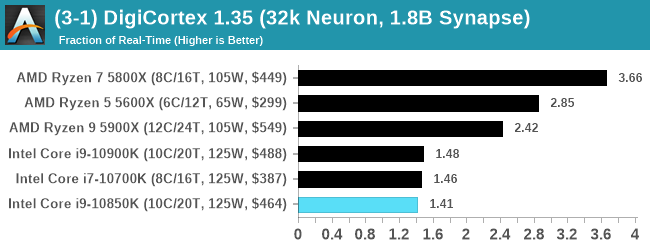
The wide variation on AMD seems to prefer high-core-count single chiplet processors. Intel is taking a back seat here, as it is also using slower memory.
Dwarf Fortress 0.44.12: Link
Another long standing request for our benchmark suite has been Dwarf Fortress, a popular management/roguelike indie video game, first launched in 2006 and still being regularly updated today, aiming for a Steam launch sometime in the future.
Emulating the ASCII interfaces of old, this title is a rather complex beast, which can generate environments subject to millennia of rule, famous faces, peasants, and key historical figures and events. The further you get into the game, depending on the size of the world, the slower it becomes as it has to simulate more famous people, more world events, and the natural way that humanoid creatures take over an environment. Like some kind of virus.
For our test we’re using DFMark. DFMark is a benchmark built by vorsgren on the Bay12Forums that gives two different modes built on DFHack: world generation and embark. These tests can be configured, but range anywhere from 3 minutes to several hours. After analyzing the test, we ended up going for three different world generation sizes:
- Small, a 65x65 world with 250 years, 10 civilizations and 4 megabeasts
- Medium, a 127x127 world with 550 years, 10 civilizations and 4 megabeasts
- Large, a 257x257 world with 550 years, 40 civilizations and 10 megabeasts
DFMark outputs the time to run any given test, so this is what we use for the output. We loop the small test for as many times possible in 10 minutes, the medium test for as many times in 30 minutes, and the large test for as many times in an hour.
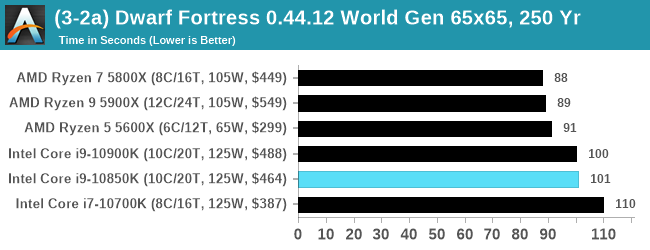
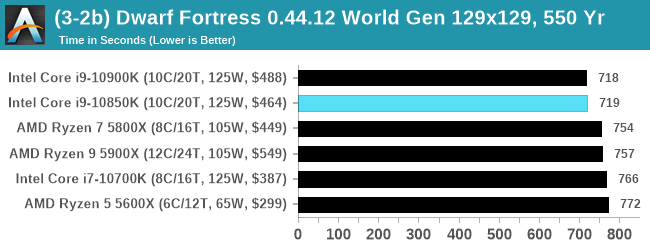
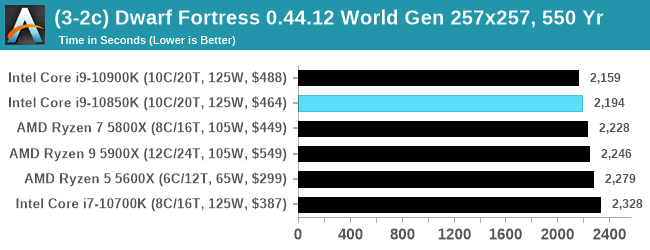
Dolphin v5.0 Emulation: Link
Many emulators are often bound by single thread CPU performance, and general reports tended to suggest that Haswell provided a significant boost to emulator performance. This benchmark runs a Wii program that ray traces a complex 3D scene inside the Dolphin Wii emulator. Performance on this benchmark is a good proxy of the speed of Dolphin CPU emulation, which is an intensive single core task using most aspects of a CPU. Results are given in seconds, where the Wii itself scores 1051 seconds.
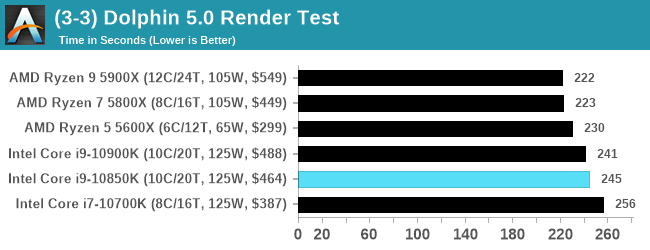












126 Comments
View All Comments
Otritus - Monday, January 4, 2021 - link
Furthermore, Intel already uses a 1+4 design in their Lakefield processors. So, 1+n designs are possible on x86.It's 2021, when will Anandtech get an edit button.
phoenix_rizzen - Monday, January 4, 2021 - link
What all these graphs show me is that AMD's Zen 3 CPU architecture is a heck of a lot better than Intel's 10th Gen Comet Lake CPU architecture.The 8-core 5800X is within spitting distance of the 10-core 10850K is many benchmarks, and way ahead of it in many others. You pay less upfront, you pay less in power/cooling, and you get better/same performance! Even in multi-threaded benchmarks where the AMD CPU has two fewer cores, but better overall performance.
Hopefully Intel get's their Tiger Lake desktop CPUs (or whatever Lake naming variation the 11th Gen stuff will be) sorted out soon. The only thing holding AMD back right now is supply issues (and a lack of support from the big OEMs like HP, Dell, Compaq, etc).
2021 will be an interesting time for those upgrading desktops... :)
Deicidium369 - Monday, January 4, 2021 - link
"Hopefully Intel get's their Tiger Lake desktop CPUs (or whatever Lake naming variation the 11th Gen stuff will be) sorted out soon" Rocket Lake 11900K is the top SKU and wrecks the 5800X"The only thing holding AMD back right now is supply issues (and a lack of support from the big OEMs like HP, Dell, Compaq, etc)" Compaq? really? You know that Compaq was bought by HP... Maybe Lenovo would have been a better choice there...
Intel provides designs for OEMs - have been doing this since the ultralight era - Intel makes it easy for OEMs to introduce a design using Intel SOCs. AMD does not do this - which is AMD's failing - the OEMs have to spend their own money designing a platform for AMD - and at some point hopefully recoup their investment - the sales volume for AMD is low enough that it often doesn't.
Chicken and Egg - OEMs won't introduce high end AMD designs due to cost, consumers won't be able to purchase a high end AMD - and will instead purchase an Intel.
IF AMD started providing designs and packages of components (like the 1W display for Ice Lake and Tiger Lake 13") to the OEMs - then AMD can start to expect higher end designs, rather than some 15" chassis from 3 years ago - by relieving the OEMs from spending $$ to engineer AMD designs, AMD would remove that burden, and also somewhat dictate what tier these designs go into ... provide the same design to all OEMs (just like Intel does)
This is not bashing AMD - they are missing several tricks to get their product in the high end laptop sector... it's not bribing or anything else - it is SMART BUSINESS.
IF AMD wants it's SOCs in high end designs like the Dell XPS - then it's not difficult to see the path forward.
JayNor - Monday, January 4, 2021 - link
TGL added integrated pcie4, Thunderbolt 4, Wifi6 and lpddr5, and already has avx512, dlboost... all in a laptop chip. When will the competition have those features?RSAUser - Tuesday, January 5, 2021 - link
Interesting that I've seen quite a few high end AMD OEM systems, they can just reuse the design of the Intel counterpart, change is just the mobo and CPU, which doesn't influence Form factor much since can get mobo with same Form factor.powerarmour - Tuesday, January 5, 2021 - link
Just wait until you see the power consumption numbers for Rocket Lake then, you'll then see who wrecks what.Makaveli - Monday, January 4, 2021 - link
Where did you see a 11900k which is unreleased at the moment wrecking a 5800x? Those leaked geekbench scores lol? Citation needed.AndrewJacksonZA - Monday, January 4, 2021 - link
So let me get this straight: A CPU with 65% more cores, 100% more power consumed, and with a 50% greater price than their competitor's smallest and cheapest CPU, is being outperformed or equalled by that little CPU.OK, right on.
JayNor - Monday, January 4, 2021 - link
"Intel likes to point out it has another 24 PCIe 3.0 lanes through the chipset, however this is limited by the DMI/PCIe 3.0 x4 uplink to the processor."Ok, through a switch, but perhaps the OEMs would have to add a switch on the motherboard if Intel only provided four lanes. Seems like a reasonable feature.
Hulk - Monday, January 4, 2021 - link
I loved the article. Well-written, very informative, and entertaining. Also little is ever written when it comes to binning. It's great to hear Ian's thoughts on this and the lengths Intel has been going to in order to stay competitive.Ian presented the facts of the case. We are the jury and make our own decisions.